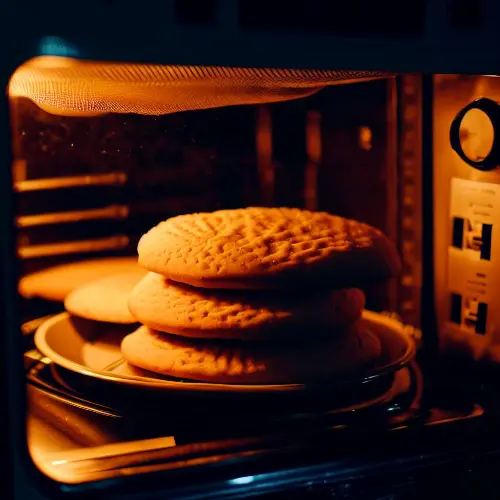Table of Contents
Can You Bake Biscuits in the Microwave?
Biscuits are a quick and easy staple that can be made for breakfast, lunch, or dinner. Typically baked in the oven, biscuits emerge with a golden brown crust and fluffy interior when done right. But what if you don’t have an oven available? Is it possible to bake biscuits in the microwave?
Yes, it is possible to bake biscuits in the microwave by using a microwave-safe dish, reducing the liquid slightly, kneading the dough well, microwaving at high power for 2-3 minutes, and allowing to cool before removing.
An Overview of Baking Biscuits in the Microwave
While microwaves are not designed specifically for baking, it is absolutely possible to bake biscuits in the microwave. The microwave generates heat that cooks food from the inside out, so baking biscuits in the microwave does work.
However, there are some drawbacks to microwaving biscuits rather than baking them in the oven:
Microwaved biscuits will not get as golden brown or develop a crispy crust on the outside. They will be softer and paler in color.
- The rise of the biscuits will be less dramatic without the dry heat of an oven.
- Microwaves tend to cook food less evenly, leading to potential cold or hard spots.
- Without a baking pan, microwaved biscuits may flatten out rather than rise up.
So while biscuits can be successfully microwaved, they will have a different texture and appearance than oven-baked biscuits. The microwave should be seen as a method for quick cooking rather than perfectly replicating traditional baking results.
Instructions for Microwaving Canned Biscuits
Canned biscuits from brands like Pillsbury are one of the easiest ways to make biscuits from scratch in just minutes. Here is a step-by-step guide to microwaving canned biscuits:
- 1. Prepare the biscuits: Open the can and separate the raw biscuits onto a microwave-safe plate, lined with paper towels. Make sure the biscuits have a bit of space between them.
- 2. Microwave in short bursts: Microwave the biscuits in 30-second intervals until cooked through. The total cook time depends on the power of your microwave but will likely be 1-3 minutes.
- 3. Check for doneness: Check the biscuits after each 30 seconds. They should puff up and double in size. The biscuits are fully cooked when they are firm and golden, and sound hollow when tapped on top.
- 4. Let cool slightly before eating: Allow the hot biscuits to cool for 1-2 minutes before removing from the microwave. Handle carefully, as the biscuits will be very hot.
- 5. Store leftovers properly: Seal any uneaten biscuits in plastic wrap or an airtight container and refrigerate. Reheat refrigerated biscuits wrapped in a damp paper towel to restore softness and moisture.
Baking Homemade Biscuits in the Microwave
Making biscuits completely from scratch in the microwave is also possible with some minor adjustments to your typical biscuit recipe. Here are some tips:
- Use microwave-safe cookware like a glass baking dish rather than metal pans which can lead to uneven cooking. Line the dish with parchment paper.
- Opt for drop-style biscuits with soft dough rather than rolled biscuits which need more structure.
- Make the dough slightly drier than usual since there will be less evaporation in the microwave. Reduce the liquid called for in a recipe by a few tablespoons.
- Shape biscuits and place them on a dish allowing for some rising room during cooking.
- Microwave in 30-second intervals until the biscuits have risen fully and look golden on top, 5-8 minutes total. Check frequently to prevent overcooking.
- Test for doneness by inserting a toothpick into a biscuit. They should come out clean when they are fully baked.
- Allow to cool for 2-3 minutes before removing from the microwave.
Reheating Leftover Biscuits in the Microwave
Day-old biscuits easily refresh in the microwave. To reheat biscuits:
- Place 1-2 biscuits on a microwave-safe plate lined with a paper towel.
- Microwave in 15-20 second intervals until warmed through, about 45-60 seconds total for 1 biscuit.
- Check frequently and stop early to prevent drying out.
- Wrap in a damp paper towel for the last 5-10 seconds only if needed to restore moisture and softness.
Microwave Biscuit-Making Tips
While most biscuit dough can be microwaved, higher-fat recipes with ingredients like shortening or butter tend to microwave more evenly.
- Whole wheat and oat flour can lead to gummier biscuits. Stick to all-purpose or self-rising flour.
- Reduce oven temperatures in recipes by 50°F when microwaving to prevent overcooking of biscuits.
- Use microwave-safe cookware to prevent overbrowning on the bottom. Glass, silicone, and ceramic are good options.
- Elevate baked goods with an upturned bowl or mug in the center of the dish to promote even rising and prevent flattening.
- Microwaves vary – get to know your appliance’s power levels and adjust cook times as needed.
- Check biscuits early and microwave in short intervals for the best results when experimenting.
FAQ
Can you cook raw biscuit dough in the microwave?
Yes, homemade or store-bought biscuit dough can be microwaved without being pre-baked. Shape biscuits and arrange them with space between them on a microwave-safe dish prepared with parchment paper. Microwave in 30-second intervals, checking frequently, until the biscuits have puffed up fully and appear lightly browned. Total microwave time will be 5-8 minutes.
Do biscuits rise in the microwave?
Biscuits will rise as they bake in the microwave, though the rise will be less dramatic than in a conventional oven. Ensure your biscuit dough includes leavening agents like baking powder or baking soda to promote rising. Arrange biscuits with space between them to allow for some spreading and rising as they cook.
How long do you microwave a biscuit for?
Microwave times for biscuits can vary based on several factors like your appliance wattage and the size and number of biscuits. A general rule of thumb is 30-second intervals until fully cooked, checking frequently. Expect refrigerated canned biscuits to take 1-3 minutes and homemade biscuit dough around 5-8 minutes total. Always microwave in short bursts and verify doneness to prevent overcooking.
Why do my microwaved biscuits get hard?
Overcooking is usually the culprit when microwaved biscuits turn out hard. Start with short 30-second intervals, checking often. Let biscuits cool for a few minutes before removing them from the microwave, as they will continue cooking. Store leftovers in an airtight container at room temperature or refrigerate and reheat biscuits wrapped in a damp paper towel.
Should biscuits be wrapped in a paper towel?
When microwaving biscuits, place them on a plate lined with a paper towel which will absorb excess moisture. Don’t wrap entirely in paper towels or the biscuits will steam. Only wrap cooked biscuits in a damp paper towel when reheating to restore softness and prevent a tough texture.
Conclusion
Baking biscuits in the microwave produces a quick and convenient if imperfect, homemade bread when you don’t have an oven. While microwaved biscuits won’t mimic the flaky layers and browned crust of traditional oven methods, they can be an easy substitute with a little finesse.
When microwaving biscuits, use short intervals, allow standing time, and adjust recipes to accommodate a microwave’s rapid heating. With the proper techniques, biscuits can become a surprisingly versatile microwave recipe.

I’m Ian Welkins, a seasoned professional in the kitchen industry. My passion now drives me to provide invaluable insights into the world of top-notch kitchen products. With years of hands-on experience, I’m your go-to source for culinary excellence.











